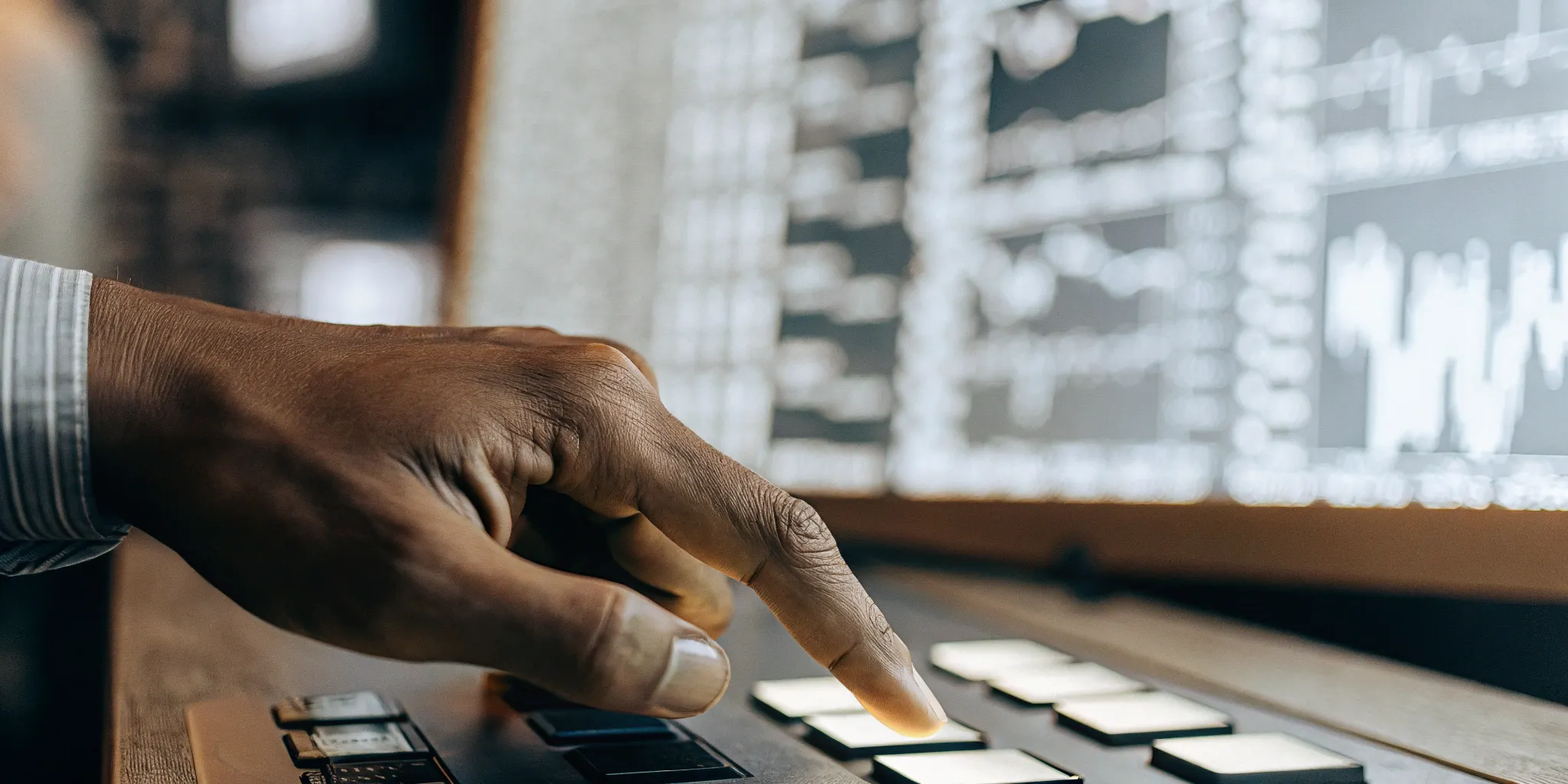Want to sharpen your trading strategies without risking real money? Backtesting with FN Capital is your solution. It’s like a time machine for your trades, letting you see how your strategy would’ve performed in past market conditions. This practical guide shows you how to backtest FN Capital step by step. We’ll cover setting up your testing environment, analyzing key metrics, and even some advanced techniques. Plus, we’ll highlight common backtesting mistakes to avoid. Ready to make smarter, data-driven trading decisions? Let’s get started.
Key Takeaways
- Backtesting is key to refining your trading strategies. Use historical data to simulate trades and analyze potential outcomes before risking real capital. Focus on key metrics like profitability, win rate, maximum drawdown, and the Sharpe Ratio to understand your strategy’s strengths and weaknesses. Refine your approach for optimal results.
- FN Capital offers the tools and data for effective backtesting. Our platform integrates seamlessly with the FAST AI algorithm and DART risk management system, allowing you to test strategies in a realistic environment. Leverage our user-friendly interface and analytical tools to make informed decisions.
- Transitioning to live trading requires a structured approach. Use paper trading to bridge the gap between simulation and reality. Continuously monitor live performance against backtested results. Regularly refine your strategies based on data from both backtests and live trading to adapt to changing market conditions.
Why Backtest Your Trading Strategy with FN Capital?
Backtesting lets you simulate your trading strategies using historical market data. Think of it as a test run for your trading plan. It helps you see how your approach would have performed in the past, giving you valuable clues about its potential. By analyzing past performance, you can refine your strategies and make smarter decisions before risking real capital. This process is especially valuable for algorithmic trading, where complex strategies can be tough to assess without thorough testing.
FN Capital offers a distinct advantage for backtesting. Our platform provides the tools you need to test various trading strategies effectively, specifically designed for the intricacies of forex markets. You can analyze historical EUR/USD data—the pair our FAST AI algorithm specializes in—to understand how different approaches would have performed under various market conditions. This targeted analysis helps you minimize risk and fine-tune your strategy for optimal results. Our platform integrates seamlessly with the FAST AI algorithm and DART risk management system, allowing you to test your strategies in a realistic, AI-powered environment. This combination of historical data and advanced AI integration gives you a powerful edge in developing and refining your trading approach.
FN Capital’s FAST AI and Backtesting: A Powerful Combination
FN Capital offers the tools and data you need for effective backtesting. Our platform integrates seamlessly with the FAST AI algorithm and DART risk management system, allowing you to test strategies in a realistic environment. This means you can simulate trades using our proprietary AI, under historical market conditions, and see how your approach would have fared. This empowers you to refine your strategies *before* risking real capital in live markets. Leverage our user-friendly interface and analytical tools to make informed, data-driven decisions, giving you a significant advantage in the competitive world of algorithmic trading.
Benefits of Backtesting with FN Capital
Backtesting with FN Capital offers several key advantages for all traders, from beginners just starting out to seasoned professionals. Here’s a closer look at how backtesting can enhance your trading approach:
Reduced Risk and Increased Confidence
Backtesting lets you simulate your trading strategies using historical market data, providing a crucial test run for your trading plan. It shows you how your approach would have performed in the past, offering valuable insights into its potential. By analyzing past performance, you can refine your strategies and make smarter decisions before committing real capital. This process builds confidence in your strategy and reduces the inherent uncertainty of live trading.
Optimized Strategy Development
FN Capital provides the tools to test various trading strategies effectively, specifically designed for the complexities of forex markets. You can analyze historical EUR/USD data—the pair our FAST AI algorithm specializes in—to understand how different approaches would have performed under various market conditions. This targeted analysis helps minimize risk and fine-tune your strategy for optimal results. Experimenting with different parameters and settings within the FAST AI algorithm allows for further optimization based on historical trends.
Understanding Market Dynamics
Backtesting with FN Capital goes beyond simply evaluating your strategy’s performance; it offers valuable insights into market dynamics. By analyzing historical data, you can identify recurring patterns, understand market volatility, and assess the impact of different events on your strategy. This deeper understanding of market behavior helps develop more robust and adaptable strategies equipped to handle changing market conditions. Our platform’s integration with the FAST AI algorithm and DART risk management system ensures your backtests reflect a realistic, AI-powered trading environment, providing a comprehensive view of your strategy’s potential.
How to Backtest with FN Capital
Backtesting lets you test-drive a trading strategy using historical data, giving you a glimpse into its potential past performance. It’s a crucial step in developing a robust approach, and FN Capital provides the tools to make it happen. Here’s how to get started:
Define Your Trading Strategy
First, pinpoint what you’re aiming for with your trading. Are you after short-term gains or sustained long-term growth? What level of risk are you comfortable with? Clearly defining your objectives and trading style will shape your strategy. This involves setting specific entry and exit rules, figuring out your position sizing, and establishing risk management parameters. Think of it as creating a roadmap for your trades.
Gather Your Historical Data
FN Capital seamlessly integrates with high-quality historical data sources, providing the information you need to put your strategy to the test. This historical data fuels your backtest, simulating real market conditions. The more comprehensive the data, the more accurate your backtesting results.
Set Up Your Backtesting Environment
FN Capital offers a user-friendly platform to design your backtesting environment. You can customize parameters, define your chosen trading strategy, and select the relevant historical data. The goal is to create a simulation that closely mirrors real-world market behavior. This allows you to test and refine your strategies before deploying them live.
Run Your First Backtest
With your rules and parameters set, it’s time to run the backtest. FN Capital’s powerful algorithmic trading engine takes over, executing virtual trades based on your defined strategy and the historical data. This generates a detailed performance report, showing how your strategy would have performed in the simulated market.

Analyze Your Backtest Results
The results of your backtest offer valuable insights into your strategy’s potential strengths and weaknesses. Carefully examine key metrics like profitability, win rate, maximum drawdown, and the Sharpe ratio. This analysis helps you identify areas for improvement and fine-tune your approach before risking real capital. Remember, backtesting is iterative. Don’t hesitate to adjust your strategy and run multiple backtests to optimize its performance.
Essential Metrics for Evaluating Backtest Performance
After running your backtest, the next crucial step is evaluating its performance. This involves analyzing several key metrics to understand the strengths and weaknesses of your trading strategy. Remember, a profitable backtest doesn’t guarantee future success, but it provides valuable insights to refine your approach.
Profitability and R-Multiple
Profitability is the most obvious metric, showing the total profit generated during the backtesting period. However, raw profit alone doesn’t tell the whole story. You also need to consider the R-multiple, which measures the relationship between profit and risk. A higher R-multiple suggests a strategy with a more favorable risk-reward profile, meaning you’re potentially earning more for every dollar risked. FN Capital’s platform provides clear visibility into both profitability and R-multiple, allowing you to quickly assess the potential of your strategies.
Win Rate and Holding Time
Analyzing the win rate—the percentage of winning trades—and average holding time provides further insight into your strategy’s behavior. A high win rate coupled with shorter holding times might indicate a scalping strategy, while a lower win rate with longer holding times could suggest a trend-following approach. Understanding these dynamics helps you assess whether the backtested results align with your intended trading style. FN Capital lets you easily track these metrics, giving you a granular view of your backtest’s performance.
Maximum Drawdown and Risk Management
Maximum drawdown represents the largest peak-to-trough decline in your portfolio’s value during the backtest period. This metric is crucial for understanding the potential risks associated with your strategy. A large maximum drawdown can signal vulnerability to market volatility and may require adjustments to your risk management parameters. FN Capital’s DART (Dynamic Algorithmic Risk Tool) helps mitigate these risks by dynamically adjusting position sizes and stop-loss orders based on real-time market conditions. You can learn more about DART and its functionality on our website.
Sharpe Ratio and Risk-Adjusted Returns
The Sharpe Ratio is a sophisticated metric that measures risk-adjusted return. It tells you how much return you’re getting for each unit of risk taken. A higher Sharpe Ratio generally indicates a better risk-return trade-off. While profitability is important, the Sharpe Ratio helps you evaluate whether those profits are worth the level of risk undertaken. FN Capital provides tools to calculate and analyze the Sharpe Ratio of your backtested strategies, allowing you to make more informed decisions.
Advanced Backtesting with FN Capital
As you gain experience with backtesting, exploring more sophisticated techniques can further refine your trading strategies and risk management. FN Capital provides the tools and data necessary to implement these advanced methods.
Incorporating DART into Your Backtests
Integrating FN Capital’s Dynamic Algorithmic Risk Tool (DART) into your backtesting process strengthens your strategy’s robustness. DART dynamically adjusts position sizes and stop-loss orders based on real-time market conditions, crucial for effective risk management. As noted in our guide on essential metrics for evaluating backtest performance, maximum drawdown represents the largest peak-to-trough decline during the backtest period. This metric is key for understanding the potential risks associated with your strategy. Using DART mitigates these risks and adapts your strategy to changing market dynamics.
DART also allows for a more nuanced approach to risk management. A large maximum drawdown can signal vulnerability to market volatility and may require adjustments to your risk management parameters. Incorporating DART into your backtests simulates performance under various market conditions, providing a clearer picture of its potential strengths and weaknesses. This realistic simulation is key for transitioning from backtesting to paper trading and, eventually, live trading with FN Capital.
Multi-Asset and Portfolio Backtesting
Don’t limit your backtesting to a single market. Diversification is a cornerstone of successful investing, and backtesting across multiple, uncorrelated assets provides a more realistic assessment of your strategy’s potential. This approach helps you understand how your strategy performs under various market conditions and identify potential weaknesses. Testing on multiple assets, as suggested in this backtesting guide, reveals how your strategy would have fared in different scenarios, giving you a more comprehensive view of its strengths and weaknesses. Analyzing performance metrics is crucial for identifying areas for improvement and minimizing risk before deploying real capital. With FN Capital, you can easily backtest your strategies across a range of assets, building a robust and diversified portfolio.
Modeling Market Conditions and Volatility
Markets are dynamic, and your backtesting should reflect this. Incorporate periods of high and low volatility to see how your strategy holds up under stress. A strategy that performs well in calm markets might crumble during turbulent times. Experiment with different timeframes—this will help you determine the optimal holding time for your trades and refine your exit strategies. This guide suggests using 2-3 months of data for short-term strategies and 6-12 months for longer-term ones. FN Capital’s robust platform allows you to simulate various market scenarios and stress-test your strategies, ensuring they are adaptable and resilient. Avoid common backtesting pitfalls like overfitting to ensure your strategy remains adaptable to real-world market dynamics.
Common Backtesting Mistakes to Avoid
Backtesting is crucial for refining your trading strategies before risking real capital. It helps you understand how a strategy might have performed historically. However, be aware of these common pitfalls that can skew your results and lead to unrealistic expectations:
Overfitting and Curve Fitting
Think of overfitting like studying for a test by memorizing the answers instead of understanding the material. Your strategy becomes so tailored to the specific historical data that it won’t hold up in live market conditions. You’ll see impressive backtest results, but disappointing live performance. A robust backtesting process minimizes overfitting by focusing on the underlying market dynamics, not just past price movements. This involves testing your strategy across various market conditions and timeframes.
Real-World Costs and Slippage
Don’t get caught off guard by the costs of trading. Spreads, slippage (the difference between the expected price and the actual execution price), and commissions can significantly impact your bottom line. A seemingly profitable strategy in a backtest can quickly become unprofitable in live trading if these costs aren’t considered. Make sure your backtesting platform, like FN Capital, accurately reflects these real-world expenses for a more realistic assessment. Learn more about the drawbacks of overlooking these crucial details.
Sample Size and Time Periods
A robust backtest requires sufficient data. Think of it like conducting a survey—a larger sample size gives you more reliable results. Aim for a substantial number of trades in your backtest, not just a handful. A small sample size can create the illusion of profitability where none exists. Similarly, the time period you analyze matters. Shorter periods might not capture various market cycles, while excessively long periods can include irrelevant historical data. A larger sample size across representative time periods provides a more accurate picture of your strategy’s potential. The right balance depends on your trading style. For short-term strategies, a few months of data might suffice, while longer-term strategies require more extensive historical data.
Optimizing Your Strategy After Backtesting
Backtesting isn’t a one-and-done deal. Think of it as a continuous feedback loop, providing insights to refine your approach. After you’ve run your initial backtests, the real work begins: optimizing your strategy for live market conditions.
Fine-Tune Your Parameters
Backtesting lets you refine your trading strategy iteratively. Use the results to fine-tune the parameters. This might involve adjusting entry and exit rules, tweaking stop-loss levels, or modifying position sizing. When you understand how your strategy has performed in various market conditions, you’re less likely to make emotional decisions during real-time trading. Remember, the goal is to create a robust strategy, not one that perfectly fits historical data. Avoid common pitfalls like overfitting and ensure your strategy adapts to various market conditions. Small adjustments based on backtest data can make a significant difference in live performance.
Validate Across Different Markets
A key aspect of optimization is validating your strategy across different market conditions. By applying your trading system to historical data, you can determine how it might perform without risking capital. Backtesting is a simulation that allows you to test your strategies using historical data. This provides critical insight into its performance across different market conditions. A robust backtesting setup allows you to test your ideas thoroughly, ensuring strategies are validated across various market scenarios. Don’t just look at overall performance; examine how your strategy performs during bull markets, bear markets, and periods of high volatility. This will give you confidence in its ability to handle real-world market dynamics.
Moving from Backtest to Live Trading
After rigorous backtesting and optimization, the next crucial step is transitioning to live trading. This leap can be daunting, but with a structured approach, you can confidently deploy your strategy in the real market. This section outlines a practical framework for moving from simulated results to live execution, emphasizing the importance of paper trading and continuous performance monitoring.
Bridge the Gap with Paper Trading
Think of paper trading as a dress rehearsal before the main performance. It bridges the gap between backtesting and live trading, allowing you to test your strategy in real-time market conditions without risking actual capital. This practice run helps you refine your execution skills, familiarize yourself with the trading platform, and gain confidence in your strategy’s real-world application. Backtesting validates your strategy, but paper trading lets you experience the emotional and psychological aspects of trading, preparing you for inevitable market fluctuations. By simulating real trades, you can identify any unforeseen challenges or weaknesses in your approach before they impact your live portfolio.
Compare Live vs. Backtested Performance
Once you transition to live trading, ongoing monitoring is essential. Compare your live performance metrics with your backtested results to ensure your strategy performs as expected. Backtesting provides a statistical baseline, but real-market dynamics can introduce variations. Regularly track key metrics like profitability, win rate, maximum drawdown, and Sharpe ratio. If you observe significant deviations between live and backtested performance, re-evaluate your strategy or adjust parameters. Consistent monitoring allows you to adapt to changing market conditions and maintain control over your trading outcomes. Successful trading involves continuous learning and refinement. By analyzing performance metrics, you can identify areas for improvement and optimize your strategy for long-term success.
FN Capital’s Unique Backtesting Features
FN Capital offers a comprehensive suite of backtesting tools designed to empower both novice and experienced traders. We understand that evaluating a trading strategy’s potential is crucial before deploying it in live markets. Our platform provides the resources you need to refine your approach and gain confidence in your decisions.
Intuitive Interface and Analytical Tools
Navigating the complexities of backtesting can be daunting. That’s why FN Capital prioritizes a user-friendly interface. Our platform offers intuitive analytical tools and clear visualizations, making it easy to interpret performance metrics and identify areas for improvement. Whether you’re exploring historical data or optimizing existing strategies, our platform provides the insights you need to make informed choices. Many trading platforms offer features to facilitate this process, helping traders gain more reliable insights into the potential success of their strategies before risking real capital. This empowers you to thoroughly test and refine your approach, minimizing potential risks and maximizing potential gains. Exness Academy offers a helpful guide to backtesting strategies.
FAST AI Algorithm and DART Integration
Backtesting is essential for minimizing risk and refining trading strategies before committing real capital. FN Capital integrates its proprietary FAST AI algorithm and DART (Dynamic Algorithmic Risk Tool) directly into the backtesting environment. This allows you to simulate real-world market conditions with remarkable accuracy. Analyzing performance metrics helps identify strategy strengths and weaknesses, ultimately improving overall success. By leveraging the power of FAST AI and DART, you can gain a deeper understanding of how your strategies perform under various scenarios and fine-tune them for optimal results. A robust backtesting environment is crucial for designing and testing algorithmic trading strategies. A comprehensive backtesting setup, from selecting the right tools to implementing best practices, allows traders to thoroughly vet their ideas, as detailed in this BlueChipAlgos article. This integration ensures that your backtests accurately reflect the dynamics of live trading, giving you a realistic preview of potential outcomes.
FN Capital Plans and Pricing
FN Capital offers flexible pricing tiers tailored to your financial goals. Whether you’re just starting to explore algorithmic trading or looking for aggressive portfolio growth, we have a plan designed for you. For a full overview of our pricing options, visit our pricing page.
Basic Plan
Ideal for beginner investors exploring AI trading, the Basic Plan offers a fantastic entry point with a Free Trial License. This allows you to experience the power of automated trading without any financial commitment—a perfect way to familiarize yourself with the platform and see firsthand how FN Capital’s FAST AI algorithm works.
Essential Plan
Ready to take the next step? The Essential Plan provides a more comprehensive experience. This mid-tier offering includes enhanced features and increased support to help you delve deeper into algorithmic trading. Explore the pricing page for a complete breakdown of what’s included.
Unleashed Plan
For serious traders seeking maximum control and performance, the Unleashed Plan is our most comprehensive option. It unlocks all of FN Capital’s tools and features, empowering you to maximize your trading strategies. Visit our pricing page for a detailed look at the Unleashed Plan’s features and benefits.
Comparing FN Capital to ValueInvesting.io
ValueInvesting.io focuses on fundamental analysis and long-term investments, while FN Capital specializes in AI-powered algorithmic trading for forex markets. This key difference shapes the features and target audience of each platform.
Backtesting Features and Functionality
FN Capital integrates its proprietary FAST AI algorithm and DART (Dynamic Algorithmic Risk Tool) directly into the backtesting environment. This allows you to simulate real-world market conditions with remarkable accuracy, providing a realistic assessment of your strategy’s potential. This integration offers a distinct advantage for traders refining their algorithmic approach.
Target Audience and Use Cases
FN Capital’s mission is to empower all individuals, regardless of experience, to achieve financial independence through our proven tools. Whether you’re new to trading or a seasoned professional, our AI-powered platform offers a streamlined approach to algorithmic trading, delivering consistent results without the complexity or emotional pitfalls of manual strategies.
Understanding the Risks of Algorithmic Trading
While algorithmic trading offers significant advantages, understanding and managing the inherent risks is essential. Market volatility, technical glitches, and unexpected events can all impact trading outcomes. FN Capital’s DART helps mitigate these risks by dynamically adjusting position sizes and stop-loss orders based on real-time market conditions. This proactive risk management is crucial for protecting your capital and ensuring long-term success.
Exploring the FN Capital Blog
Our blog is a valuable resource for staying informed about market trends, algorithmic trading strategies, and the latest developments at FN Capital. It’s a great place to deepen your understanding of AI-powered trading and learn from industry experts.
Meet Isaac Adams
Learn more about FN Capital’s founder, Isaac Adams, and his vision for the future of algorithmic trading. He and his team prioritize full transparency, verified performance, and a customer-centric approach to investment growth.
Recent Blog Posts
Stay up-to-date with our latest blog posts covering algorithmic trading, market analysis, and FN Capital’s innovative tools. We regularly publish educational content designed to empower both novice and experienced traders. Learn more about backtesting, AI strategies, and other valuable insights.
Get the Most Out of FN Capital Backtesting
To really get the most out of FN Capital’s backtesting features, focus on a few key strategies. These will help you refine your approach and gain confidence before live trading.
First, become familiar with the platform’s backtesting software. FN Capital offers robust tools that let you simulate trades against historical data, giving you a preview of potential outcomes. This is like a dress rehearsal for your trading strategy, allowing you to identify strengths and weaknesses before risking real capital.
Next, remember that a realistic backtesting environment is crucial. Make sure your settings accurately reflect real-world market conditions, including factors like slippage and commissions. This helps avoid overly optimistic results that wouldn’t hold up in live trading. Think of it as testing your car on a track before taking it on the open road. Reviewing past performance is key to refining your current strategy.
Pay close attention to performance metrics after each backtest. Don’t just look at profits; analyze metrics like maximum drawdown, win rate, and Sharpe ratio. These offer a more complete picture of your strategy’s risk and potential. Understanding these metrics is like checking your car’s vital signs—it tells you what’s working well and what needs attention.
Finally, be mindful of common backtesting pitfalls like overfitting and data snooping. Overfitting occurs when a strategy is tailored too closely to historical data, performing poorly in live markets. Data snooping involves repeatedly tweaking parameters until desirable results appear, creating a false sense of confidence. Avoiding these pitfalls is like ensuring your car is properly maintained and not just relying on a lucky streak. By following these tips, you can use FN Capital’s backtesting capabilities to develop robust, data-driven strategies for long-term success.
Related Articles
- Algorithmic Trading Tutorials: A Practical Guide – FN Capital
- Algo Trading for Beginners: Your Step-by-Step Guide – FN Capital
- What is Automated Trading Software? Your Guide to Algorithmic Trading – FN Capital
- How to Backtest Algo Trading Strategies: A Practical Guide – FN Capital
- Futures Algorithms: Your Guide to Automated Trading – FN Capital
Frequently Asked Questions
Why is backtesting important for my trading strategy? Backtesting lets you see how your trading strategy would have performed in the past, offering valuable insights into its potential strengths and weaknesses before you risk real money. It helps you refine your approach and make more informed decisions. Think of it as a test run for your trading plan, allowing you to identify potential issues and optimize your strategy for better results.
How can I access historical data for backtesting? FN Capital integrates seamlessly with high-quality historical data sources, providing the information you need to test your strategies effectively. This data allows you to simulate real market conditions and assess how your approach would have performed in the past. Our platform offers easy access to this data, making backtesting a straightforward process.
What key metrics should I focus on when evaluating backtest results? Look beyond just profitability. Consider metrics like the R-multiple (profit relative to risk), win rate, maximum drawdown (largest potential loss), and the Sharpe Ratio (risk-adjusted return). These metrics provide a more comprehensive view of your strategy’s potential and risk profile. Understanding these metrics helps you make more informed decisions about your trading approach.
How can I avoid common backtesting mistakes like overfitting? Overfitting happens when your strategy is too closely tailored to the historical data, leading to disappointing live performance. Avoid this by testing your strategy across various market conditions and timeframes, ensuring it remains adaptable and robust. Focus on understanding the underlying market dynamics rather than just memorizing past price movements.
What are the next steps after a successful backtest? Transitioning from backtesting to live trading requires careful planning. Consider paper trading to practice your strategy in real-time market conditions without risking real capital. Once live, continuously monitor your performance and compare it to your backtested results. This ongoing assessment helps you adapt to changing market dynamics and refine your strategy for long-term success.





